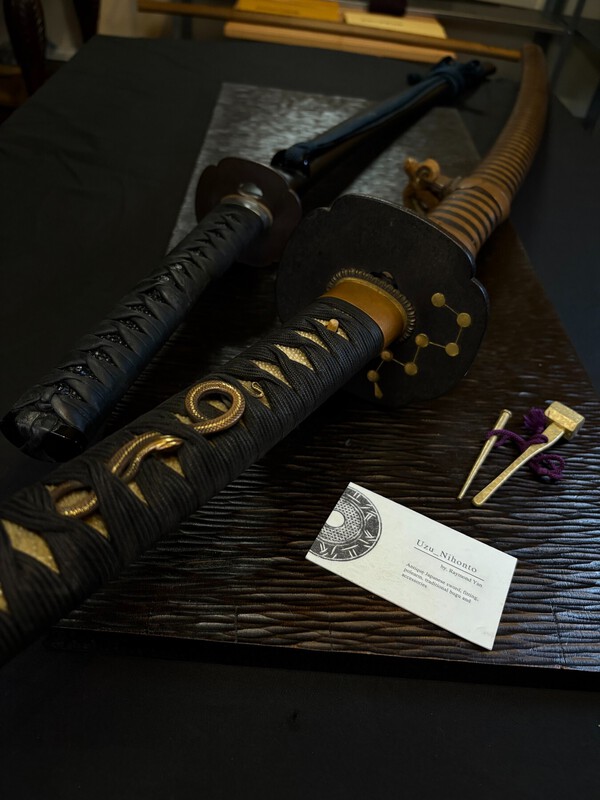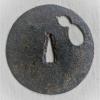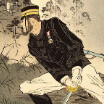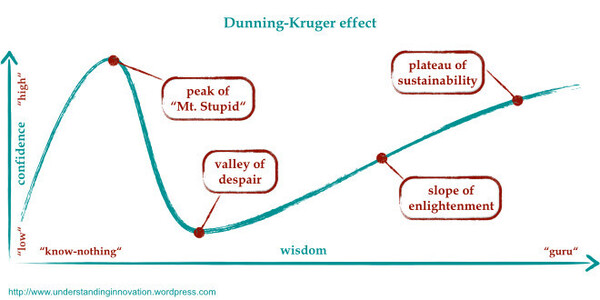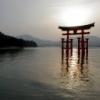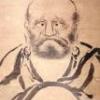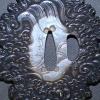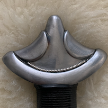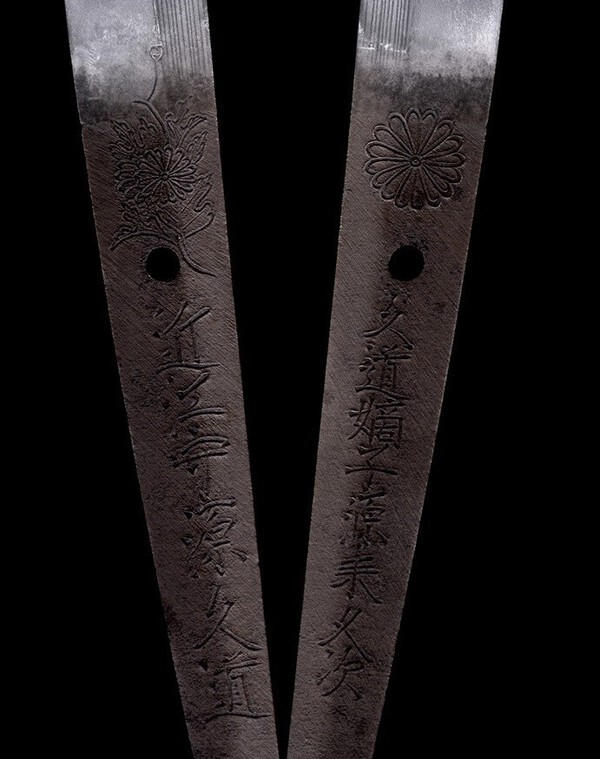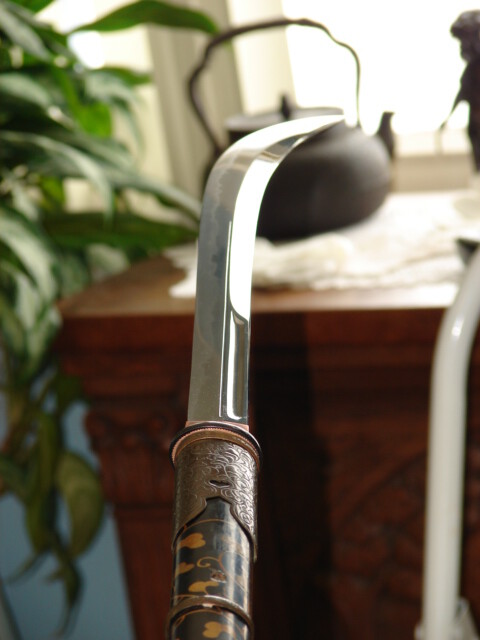Leaderboard
Popular Content
Showing content with the highest reputation on 01/02/2025 in all areas
-
Happy the year of 蛇 Snake! a perfect first-piece-of-the-year to share for a great beginning 三尺刀 Sanjaku-to (swords with 3 Shaku blade length) itself is already very rarely seen in Nihonto market, which most of them are stored in museum, Jinja shrines and private collections, not to mention a fully mounted 大太刀Odachi/ 野太刀Nodachi like this particular piece this sword has a Nagasa blade length of around 三尺五寸 3 Shaku 5 Sun (~106cm) and a full length of 五尺一寸五分 5 Shaku 1 Sun 5 Bu (~156cm), solid, healthy and strong. As a size refefence, the Katana with black 天正拵Tensho Koshirae has a Nagasa of over 2 Shaku 4 Sun (~73cm), the Katana with purple 突兵拵Toppei Koshirae has a Nagasa of around 2 Shaku 3 Sun (~70cm) the Koshirae is mounted with 一作 Issaku full set copper fittings, including the 笛巻塗りFuemaki-nuri style Saya which is reinforced by over 50 copper rings! Combined with the dark 青貝Aogai lacquerwork in between the copper rings, with such extrodinary length, the overall Saya design reminds me of the image of a large slithering python. The long, large and thick Tsuka is mounted with a set of large 大目貫O-menuki in the design of 蛇Hebi snake, which the large iron Tsuba has gold inlay of 北斗七星Hokuto-Shichisei "Big Dipper". Photo records of such pieces are very rare to find, and personally, I would definitely want to see more of such samples published on internet for the sake of study and enjoyment. Hope you enjoy the photos, and hope a great year of snake is waiting!8 points
-
Greetings all, While I have only just become an official member of this community, I have been a long time viewer. I am very fortunate to have had the opportunity to mingle in the same circles as those far more knowledgeable than I in all things nihonto. That said, having been a jeweler for over two decades this thread seems as good as any to see my first post. Although I have only worked in precious metals, there may be some similarities when discussing production. I am a custom jeweler, meaning customers bring me images or drawing of jewelry designs and I build them from scratch. Although I leaned how to do this on a completely handmade level during my apprenticeship, I quickly found it was far more advantageous to utilize a CAD/CAM system of production. I say this because technically, while my designs are one of a kind and custom, the items I make are NOT 100% handmade. This now leads into a discussion about value. If I make a ring and the cost to produce it is 4k, I would argue the value of that ring is in the fact that it is one of a kind, made by a competent craftsman, coupled with the sum of its parts. An identical ring made completely by hand where the metal is rolled cut and formed is going to be more expensive, however, will it be more valuable or superior in its construction? I would argue no, for a few reasons that at this point are unimportant. Now let's bring this back to the discussion at hand. Dan's repeated and unrelenting question has persisted through this thread. Is it possible for cast iron tsuba to have been cast in the Edo period. IMO, the answer is yes, however unlikely. I say unlikely, as others have previously, because I believe it would not have been a secret. Casting was not a frowned upon means of production. If casting tsuba was a method being used, I very much believe it would be well documented considering the number of craftsmen that were producing tosogu in that period. I believe it plausible to have been done using a method that would have produced a superior result compared to what we can create today and the recipe for that process was lost. I dont find this likely, but accept it was possible. If I have to play devils advocate, I actually believe more in the idea that has already been proposed in this thread of a possible hybrid method of tsuba manufacture. Perhaps there was a method by which cast iron was cast into blank plates saving the craftsman from having to start from scratch. The only reason why I still find this dubious is because of my experience as a craftsman in my own discipline. As a jeweler, there are items I have made which required basic skills that would seem really time consuming to the layperson. Muscle memory and years of repetitive practice have made these skills quite ordinary and not as time consuming as one may imagine. So with that in mind I have to ask if cast blanks were available, would they have actually been so labor saving that it was beneficial to use them? For me, I would say no. So where does this leave us? The question I have been asking myself is why Dan seems so desperate to have this hypothesis realized? Dan if you are reading this, what is your ultimate goal in this pursuit? When will you have the requisite satisfaction that allows you to move "onward"? Until such a time as you can provide empirical evidence to prove you claim, you have only "faith". Continued posting of anything else other than definitive evidence would seem to be only for the purposes of provocation. You are free to do so of course as this is a public forum, but it does seem as if the horse is well and truly beaten at this point. Nevertheless, I hope you are able to eventually find what you are seeking.7 points
-
Hi John, in the EDO period, the Japanese had iron casting technology, and it was mastered in very good quality. They had furnaces to heat up iron to its melting point (1.538°C), and of course they would have been able to cast small objects like TSUBA! They used the "lost mold" (not 'lost wax') technology learned from the Chinese, and it was not the same as our modern 'sand-casting', but for the molds they used a mixture of clay and sand to produce a fine surface. The problem in the discussion here about this subject is the lack of knowledge about iron casting and annealing, but also about Japanese history. Making a mold for casting is a lot of work. You have to make a 'master object' first, considering the shrinkage of the desired final object. Using this, a two-piece mold was made that had to be heated up for casting so the molten iron could run freely into the finer structures. After cooling, the mold had to be destroyed to 'free' the cast object. Cleaning and cutting-off sprues and air-ducts had to follow, together with careful filing-off casting seams. Annealing to make the objects less fragile was an additional process, necessitating fuel (charcoal) and furnaces, adding to the production costs. This single-item process was labour-intensive, not resulting in cheap mass-production! Only when industrial steel production came up in the late 19th century, chill-casting was invented which allowed mass-production and low item prices. In EDO JIDAI, there was no demand for cast iron TSUBA that could be substantiated. "Normal" people (so-called 'commons) had no use for TSUBA, and wealthy people could afford traditionally made ones. Generally in the Japanese culture, hand-made objects were (and are) highly appreciated. Mass-produced small 'art' items are still considered trinkets or giveaways today. The other side should also be looked at: Forging was a well established craft in Japan, as we all know. Forging a TSUBA blank is really easy and not time consuming, and they used simple iron for it which had good toughness as opposed to cast iron. We know that not all TSUBA were made by a single workshop, but some traditions/schools used ready-made blanks and decorated them in a more artistic way. Coming to your post, we have to differentiate between "smelting" and "melting". You can feed an OROSHIGANE kiln with old iron objects that were originally made from TAMAHAGANE. The result would then be a kind of bloom looking very close to a TAMAHAGANE bloon (= KERA), differing possibly only in the carbon content. There is no melting intended in this process! Of course you can also use scrap iron of any alloy type in an OROSHIGANE kiln, but the resulting bloom would not have the properties of TAMAHAGANE and could not be treated the same way. The main purpose of this special process besides the recycling is to control the carbon content. With this short abstract, I have only scratched the surface of these technologies, but I wanted to show that throwing assumptions and guesses around is never a basis for true research. Often, the reality is not what we want it to be.6 points
-
5 points
-
That's only 1 idiot. Most if the rest are open to knowledge and serious students.5 points
-
Arrogance is some guy named "Joe" buying a hundred dollar rusty blade on ebay, who doesn't have a clue that the rusty $100 blade he just purchased may actually be a $5,000 blade, or a $50,000 blade, or perhaps even a $100,000 blade, because it's all the same to him after all, who then, without the proper training in the art of kantei, and without any formal training in the art of Japanese sword polishing, goes ahead and puts that blade to stone somehow believing (who knows what, really), that he can save this blade, make it look acceptable again, a blade that might be as thin as 3mm, which leaves absolutely no margin for error in correcting and reshaping the foundation, and then, ooops!, he removes the last bit of metal that was needed to have it properly restored and saved. And if you don't believe that it can happen you would be wrong. In fact it has happened to collectors and even amateur polishers that should have known better. https://www.nihontoc..._Sword_Polisher.html4 points
-
No one said that. What we are saying is we don’t support it, recommend it, justify it, talk about it, teach it, or acknowledge it as a proper practice here. PLEASE read (or reread) the very first post in this thread. It answers all the ‘why’s’.4 points
-
What are your thoughts on this hataraki right above the habaki? There are a number of short dark lines that are all seemingly running at the same angle. They look like chikei to me but to have so many running in the same direction isn't something I've seen previously. I tried to capture pictures in various lighting to better show what I'm seeing.3 points
-
I can guarantee you that most who buy these project blades and want to polish them themselves, don't really care about Nihonto, the tradition or the history. They just want a "Samurai sword" and age is more important than quality. They want a nice overdone painted on hamon that screams artificial, and to say to people "look, this is a gen-u-ine Samurai sword" They don't want to preserve it and use gentle uchiko over many years until you can make out the hamon and start to see some hataraki under the grey...and then hope oneday someone will complete the proper process. They want instant gratification or to flip it on eBay for a profit. They also forget how many of us "purists" DO have project blades in our own collections. But we resist the urge to polish them...gaining satisfaction from the fact that we can still enjoy the sugata, fittings (if any) and research what we have from the little we can see. Once you round off the shinogi and make the yokote disappear or skew (and they always so) and take away all the niku....the amount of metal removal to bring it back is extensive and likely takes off hundreds of years off its life. At the very least, have a polisher open a window and tell you if the sword is a kazu-uchimono with ware everywhere, or if there is something to have checked out. Either way, as a forum dedicated to the study and preservation, we will NEVER encourage this, and that fact should be obvious.3 points
-
… and for those that think I haven’t made any mistakes. Long ago I purchased a WW2 US M1 carbine bayonet for about (at that time) $50. I decided in my ‘inifinite wisdom’ that it would be cool to sharpen it. I took what is now worth about $150 (give or take) and made it worth $0. I have kept that blade as a monument to me “not knowing what I didn’t know” and as a reminder that my arrogance has consequences. Regret is a terrible teacher and destroying a piece oh history a poor legacy on my part..3 points
-
I don’t believe they don’t care… initially. I believe they don’t ‘know’ or ‘understand’ what they are contemplating doing. We are here to help them with that. After we do that… if they still proceed… THEN they don’t care. And here is where I struggle with some of our members and the “how” we do it. Yes, we can be sarcastic, or rude, or make snide comments, or be so direct that a kick in the nuts seems tame and claim “we are just being brutally straightforward and everyone immediately needs tough love because that’s what happened to us”, or we can try to understand that they “just don’t know what they don’t know” and try to guide and teach. There is always time for a boot to the sack later if they won’t listen.3 points
-
Bruce makes a fine point and I agree. There is one looming question that never seems to be answered without sarcasm or defensiveness on this issue. The question is......WHY? I'll come back to this. I am a Gen Xer, arguably that last generation worth a damn when it comes to common sense and understanding the value of a hard days work. The societal mantra of today however, seems to be, buy anything you want and once owned, it's yours to destroy. Technically, this is true, but it certainly speaks volumes about those who adhere to such a concept. That said, there are more reasons than ever to adhere to this philosophy as we live in a world where being provocative can be profitable. Profitable in that people will pay good money to someone unqualified because they think there is a chance they have found a bargain. It's profitable for those who make a living on social media poking the bear on long standing traditions just for views and comments, hoping it will go viral and in turn be profitable in the long term. What I find interesting is that usually when you find DIYers, what you DONT find is passion. However, if you do happen to find what they are ACTUALLY passionate about and apply the same "own it, destroy it" concept, all of a sudden the light bulb goes on. So, back to my initial question, WHY? I am not asking why someone would choose to attempt a polish on nihonto, My question is why would you begin your journey into polishing on nihonto when there are literally hundreds of thousands of modern made blades out there at your disposal to ruin? The answer is always going to be the same, because THEY DONT CARE. DIYers dont care about the history, they dont care about the discipline, and they dont care what any of us think. The world is theirs and we are just living in it and you know what, they have every "right" to feel this way. What they DONT have a right to do is expect any help or guidance on a forum like this where members DO care. I firmly believe that the only thing we can do is abstain from lending any guidance or wisdom even in its most basic forms, which seems to be the case here. Will this stem the problem of DIYers ruining art, even poor quality art, NOPE, but it certainly won't make it easier for them. The issue for many is being able to abstain, assertively. Loosing composure and employing sarcasm or other such snobbery only, IMO, only serves to weaken our community as a whole. The best conversation we can have on DIY polishing, IMO, is NO conversation at all, crickets. No flipping out as Bruce alluded to, no condemnation or other public shaming......just crickets.3 points
-
What better way is there to start the new year than with some gendaitō reading material. Mal & Co., Ltd have thoroughly revised the two part treatise on Japanese naval swords. This was a major, full-time, undertaking by Mal & Sueko that took months to accomplish and the results speak for itself. Do give Mal a big thanks for all that he has done via the download pages linked to below. Lets support those that help us be better informed collectors. Cox, Malcolm E. Japanese Naval Swords, WW 2: Swordsmiths & Workshops. Part 1. Updated. 2024. A4 size, color illustrations, 132 pages. Japanese Naval Swords Part 1 Cox, Malcolm E. Japanese Naval Swords: Swordsmiths & Workshops. Part 2. Upgraded. 2024. A4 size, color illustrations, 166 pages. Japanese Naval Swords Part 23 points
-
The Connoisseurs Book of Japanese Swords ..... AUD75 Gendai Toko Meikan ....... AUD50 Japanese Military and Civil Swords and Dirks.... AUD100 The Craft of the Japanese Sword ......AUD30 Shokan, Hirohitos Samurai ...... AUS40 Dawsons Encyclopedia Swords of Imperial Japan ..... AUD250 They are all hard cover books, some of the best reference books available, in good condition and are well below current prices. Postage extra depending on location.2 points
-
Nobody forgot. It was addressed directly by Mark just a couple comments later. To summarize: how does a beginner determine if a rusty blade is worth 100 or 10,000? The answer is, in this situation: Uninformed speculation and assumptions based entirely on it's 'for-sale' price. That's just simply not good enough. It's entirely counterintuitive to what we should be striving for in this community. I encourage everyone to read, and reread everything Brian has said. He said it better than me. Cheers, -Sam2 points
-
2 points
-
Just want to share the photos for the sake of study and reference, I'm a bit frustrated that photo references of such pieces are very rarely find on the open internet, hope this help2 points
-
2 points
-
I'm sure this question will have been asked and answered earlier in this thread so apologies for the repetition, however, if smelting iron was an option, why wasn't it used in weapons making? Why persist with a tatara to produce tamahagane and for smiths to make their own oroshigane when there was another process, probably less of a PIA than the tatara, that could get you an ingot of iron that could be used to make a sword? If you hadn't noticed, the Japanese in the Edo period and earlier did like swords and lots of them and, if there was some process that would have made processing the raw material easier, is it not likely that this would have displaced the other technologies available? According to another thread on here and from our own Jean Colin, even an oroshigane kiln doesn't heat iron or steel to the degree considered to be smelting, so where did the cast iron tsuba come from? Anyway, this thread is pretty much the turd that just won't flush and I don't expect any logical argument to send it down the tubes so this will be my one and only contribution to it other than to suggest to Dan that if he has proof that the technology and capability to make cast iron existed in the Edo period and has primary sources that show this the please post those references or take the absence of proof positive as the end of the argument.2 points
-
Amateur polish, looking very gaudy. But in this case, gentle uchiko over time should subdue it a bit. Westerners often think that a hamon should be so prominent that it looks like it was painted on. But the sword appears real. Ignore the tassel and decide if the price is worth it for the sword alone.2 points
-
2 points
-
Yours might be paint or urushi as well..doesn't really matter.2 points
-
Practitioners who cut regularly in Japan will simply have their swords sharpened on a stone, without proceeding to true polishing stages (see photo). This takes only a few minutes. As mentioned above, there are also some togishi who offer a “batto polish,” which is maybe around $1000 and not as extensive as an art polish. To the untrained eye a batto polish looks nice though! Not all traditionally made swords are meant to be art. But knowing and appreciating the difference is important. I train with both non-Japanese shinken and shinsakuto.2 points
-
1 point
-
1 point
-
This is amazing info, thank you all for replying! The age of these swords always amazes me, and I appreciate the knowledge of the people on this board!1 point
-
1 point
-
Wow. Stunner! I love that copper theme. Do you have dimensions of the fuchi and kashira?1 point
-
Good points, Mark. I suppose if I were the one wanting to try my hand at it, I'd take the blade to the Nihonto Forum and ask - Is this salvageable or trash? THEN, move from there, depending upon opinions given. The guys, like you say, that argue with the experts cannot be helped. We do see that often, unfortunately. Makes you wonder why they even ask, if they aren't prepared to accept what they hear.1 point
-
Of the 3 holes, one is in the "classic position" (upper) , other two (both) close to the final part of the tang (down) and very close each other. Thank very much John1 point
-
1 point
-
This used to be my sword! I traded it to a well-known member of the military swords Facebook group for a kai gunto kanemichi showato some months ago. I acquired it from a different FB group member about a year before. The blade is suriage or o-suriage mumei. I always believed it was sue koto. There is a single togari-ba element on the omote side (otherwise suguha), so possibly Mino den? The tsuba is the good early-style large/thick version. Glad this sword found its way into good hands. Your pics are better than mine!1 point
-
this reminds me of a wonderful movie, when the last sword is drawn, when the main character, played by kiichi nakai, a country samurai and a teacher, tells his fellows to stay alive and to not stop swinging the sword in order to keep the enemy away. he simply wanted everyone to stay alive.1 point
-
The perfectionist in me demands I repeat the correction from the other thread. Please forgive: The theme as described on the paperwork is 雨龍 (amaryū, or rain dragon), not 雲龍 (unryū, dragon in clouds).1 point
-
The boushi appears to be intact, but perhaps another photo (take 20 of them!!) with slightly different angles may show more. What I see is that the hamon continues around in kaeri meeting muneyaki. But much more exciting is the seeming appearance of a tobiyaki in the 'round' of the hamon kaeri. Am I wrong?? I have only one reference in my decrepit brain banks of such a feature. Glenn, can you also please do your magic on the other side of the kissaki as well as the hamachi that David has asked for??? Best regards, BaZZa. aka Barry Thomas.1 point
-
G'day Guys, The mei on this wakizashi reads: "Eda Kikumon Omi no Kami Minamoto Hisamichi" and "Kikumon Hisamichi chakushi Minamoto Rai Hisatsugu" I think the second generation Hisamichi originally signed Hisatsugu. Does this mean this wak is a gasaku between the first and second generations of Hisamichi or the second and third generation hisamichi? Cheers, Bryce1 point
-
Dear Bob, I'm with Geraint - that's an excellent face! Very expressive. Bob, I know that you know the subject is Moso, but for some of our colleagues who don't know Moso's story, here's a summary that I recently wrote for someone else: We sometimes see a man with a straw hat and mino (rain coat) or hoe digging up a bamboo shoot in the snow on tosogu. If we see this in a museum or book, usually the caption is nothing more than "Moso and bamboo shoot" leaving the viewer rather flat and uninspired. Many of the collectors that I know would shun this type of tosogu thinking that must have been for tourists or merchants because no “self respecting Samurai" would want a farmer on his tosogu. However, when you know that Moso is one of the classical paragons of filial virtue who was held in very high regard by Samurai as a reminder to be faithful to their parents and family, it changes your appreciation of the piece. As you may know, Moso’s mother was on her deathbed and she expressed a desire to eat stewed bamboo shoots (usually a Spring delicacy). It was snowing and the middle of Winter, so Moso knew that there wouldn’t be any bamboo shoots. Nevertheless, he hiked many miles into the mountains where the bamboo grew and started digging in the snow while weeping about his mother’s impending death (makes the expression on his face on your kozuka more meaningful). The gods rewarded his devotion by causing bamboo shoots to spring up under the snow, so Moso was able to grant his mother’s last request. A sword with this motif would have been an excellent gift from Samurai parents to their son, or for a Samurai who wanted a daily reminder to serve his family well. This knowledge would not only prevent some collectors from passing up such a sword/tosogu, but should also significantly add to the enjoyment of the owner/viewer who now has some insight into the life and character of the Samurai who carried the sword/tosogu.1 point
-
1 point
-
No. 19 - A modern ( less than 100 years old ) tsuba 9.0cm x 8.5cm x 0.5cm . Copper with gold and silver inlays. Closest I could come up with , in keeping with the time of year. I have asked for an interpretation of the ' judgement ' from the very talented members in the translation section of the board , but please feel free to pass your own verdict. The rear of the tsuba is also shown - a little earlier than I would normally post - to give whoever is interested a bit of time to come up with what might be on the front . All will be revealed late tomorrow ( Thursday ) . Please do not worry , due gravity and seriousness will apply again from item 20...1 point
-
No.17 - Tsuba in sentoku and copper with gold , silver and shakudo highlights , beaded shakudo rim. 7.0cm x 6.4cm x 0.4cm. Possibly Nara school late18th/early 19th cent. An unusual combination of metals , acquired eight years ago at auction. Simple , nicely executed design , reminding me of scroll / screen paintings.1 point
-
No.14 - Iron Sukashi attributed as Owari. Mumei , probably mid edo period 8.75cm x 8.51cm x 0.49cm , but over rim , 0.55cm Simple design of vertical stripes gives an strong , almost brutal impression. Acquired 15 years ago, direct from Japan. Iron bones appear on edge - I never really think of bones as a desirable feature these days , surely they are just visible evidence of poorly worked iron ? Or is this another manifestation of selling indifferent workmanship as something special - a bit like Wabi Sabi ? Please let me have your thoughts....1 point
-
1 point
-
1 point
-
1 point
-
1 point
-
1 point
-
1 point
-
Usually if I post something it will be in relation to some unusual item, or a Tanegashima that I am working on. So I thought just in case you guys think I am on the wrong forum, ... here's a very nice Naginata from my collection for everyone's enjoyment. It is I believe a First Generation ..... Kikumon Omi no kami Minamoto Hisamichi. It would appear from examination of his signatures to be a later work circ. 1695 - 1705. I particularily enjoy the Mishina School Smiths and if opportunity presents itself I try to aquire examples. I am not an expert in photograhing blades, but I think at least some of the many workings in the blade will present themselves. Anyway it is a shown here for your study and enjoyment. If someone knows the family name for the styalized cross in a circle mon, I would appreciate identification, as I have come up empty in my reference book on " Mon ". Kind regards, ... Ron Watson1 point
-
Jacques, ... Firstly I respect your opinions on the subject of swords about as high as anyone. You may be correct that this is a ghost work by the Nidai, ... but having looked at oshigata of known examples of the Nidai ghost signatures, ... the mei on this naginata is to my eyes quite different from the way the Nidai signed for his father, whereas once again I refer to the same reference book only this time to page 88 and 89 wherein the same sword is again pictured . Paragraph 7 states .... " Each of the signatures was signed by each of these two smiths ( including the mon )." I do not have your knowledge and I most certainly respect your opinion, ... but on the basis of my studies I must disagree with you on this one. ... Amicalement, ... Ron Watson1 point
This leaderboard is set to Johannesburg/GMT+02:00






